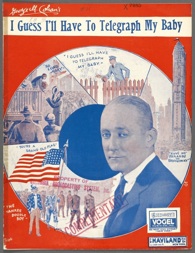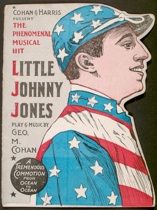George M. Cohan:
Architect of the American Musical
George M. Cohan revolutionized American musical theatre by fusing European operetta traditions with American musical entertainments such as vaudeville, burlesque, and the minstrel show. In doing so, he introduced a number of innovations to the musical stage, including songs and dialogue written in the vernacular, a new conception of tempo and delivery, employment of theatricality as a device for entertainment and a symbol for life, new subject matter that captured the spirit of the middle class, and an exuberant flag-waving patriotism. Lyricist/librettist Oscar Hammerstein II remarked that “never was a plant more indigenous to a particular part of the earth than was George M. Cohan to the United States” (Flynn 121).
Cohan was born in July 1878 (according to Cohan, on the 4th of July) in Providence, Rhode Island. He spent his formative years touring with his father Jerry, mother Nellie, and sister Josie in a vaudeville act known as the Four Cohans. At the age of thirteen, Cohan landed his first starring role as the title character in Peck’s Bad Boy – a role that served as a model for Cohan’s own playwriting and marked the beginning of his reputation as an aggressive and arrogant individual. At the age of fifteen, Cohan took over the management of the Four Cohans, and – at the age of seventeen – began to contribute songs and sketches for the act. By the end of the 19th century, the Four Cohans were the top act in vaudeville.
In 1901, The Governor’s Son premiered on Broadway; it was the first full-length musical to feature book, music, lyrics, direction, and choreography by George M. Cohan. In 1904, Cohan partnered with producer Sam H. Harris to present Little Johnny Jones. Conceived as a star vehicle, Jones was the first of Cohan’s flag-waving productions, and it featured two songs that have become a part of Americana – “Yankee Doodle Dandy” and “Give My Regards to Broadway.” Cohan’s next Broadway effort, entitled Forty-five Minutes from Broadway, was written as a vehicle for Fay Templeton and Victor Moore. It was the greatest musical comedy success in New York since The Black Crook. Cohan solidified his success as well as his reputation for patriotism with his next show, George Washington, Jr., which introduced the song “You’re a Grand Old Flag.”
Throughout his career, Cohan penned twenty-one musical comedies. He also wrote a number of plays, including Popularity (1906), Seven Keys to Baldpate (1913), and a satire on melodrama entitled The Tavern (1920). In 1936, Cohan was awarded a special Congressional Gold Medal for his contributions to the World War I effort in writing the songs “Over There” and “You’re a Grand Old Flag.”
George M. Cohan died on November 5, 1942 of intestinal cancer. Two days later, a Solemn Requiem Mass was held at St. Patrick’s Cathedral in New York City; it was the first time in the cathedral’s history that a secular song (“Over There”) was played on the organ. A statue of Cohan, erected in 1957 at 46th Street in Times Square, still stands.
--Brett D. Johnson
Sources and further reading:
Cohan, George M. Twenty Years on Broadway and the Years It Took to Get There. New York: Harper & Brothers, 1925.
Flinn, Denny Martin. Musical! A Grand Tour. New York: Schirmer Books, 1997.
McCabe, John. George M. Cohan: The Man Who Owned Broadway. Garden City, NY: Doubleday, 1973.
Morehouse, Ward. George M. Cohan: Prince of the American Theater. New York: J. B. Lippincott Company, 1943.
*Images courtesy NYPL website.





